Although Hurricane Irene battered the North Carolina coast, Duke and the Triangle came out mostly unscathed.
The only damages Duke sustained during the Category 1 storm Saturday were two fallen trees near East Campus, said Vice President for Human Resources Kyle Cavanaugh, who also acts as emergency coordinator for the University. One tree fell near the entrance of the West Duke Building and another at the intersection of Trinity Avenue and Buchanan Boulevard.
Unlike the city of Durham, which experienced numerous power outages, the University avoided large scale power outages, as the fallen trees did not bring down power lines affecting campus, Cavanaugh added.
The hurricane, which made landfall Saturday, brought one to two inches of rain and wind speeds of 35 mph to Durham and Wake counties, said meteorologist Kathleen Carroll of the National Weather Service in Raleigh. Most of the storm stayed to the east of Interstate 95 as forecasted. Those areas saw as much as six inches of rain.
Hurricane Irene left the state between 3 a.m. and 4 a.m. still as a Category 1 storm, Carroll added. The National Weather Service downgraded Irene to a tropical storm by Sunday afternoon as it moved north along the East Coast.
No one was injured by the falling trees on campus, though Duke Emergency Medical Services was called on the scene as a precaution, said EMS Director Ryan Lipes, a senior.
Cavanaugh said constant communication between major departments on campus, including Student Affairs and Parking and Transportation, helped ensure that people remained safe on campus.
“By and large, we are feeling very fortunate about our circumstances, especially compared to what happened on the coast,” he said.
Six fatalities occurred in N.C. coastal counties as of Sunday, said Marge Howell, public information officer of the North Carolina Emergency Management Division. Three of the deaths were caused by car accidents, and two others died from falling trees. One person died of a heart attack while making preparations to evacuate. The state also experienced 525,000 power outages and 228 road closures.
The total number of outages and closures for Durham and Wake counties were not available as of Sunday night, though there were reports of outages in those areas as late as 3 a.m. Sunda, Howell added.
Durham residents also reported sporadic power outages via neighborhood listservs. There were also at least four reports of fallen trees throughout Durham as of Sunday morning, Lieutenant Lyle O’Neil, Durham Police Department watch commander.
“This is still an ongoing situation,” she said. “We still need to judge the impact of the hurricane and determine the damage.”
Howell noted that flooding caused by higher levels of water in inland rivers is still a major concern. Damage to some water treatment facilities may present a major health risk.
North Carolina will receive federal assistance to repair infrastructure, though the state is still surveying the extent of physical damage. North Carolina was one of many states on the East Coast that received pre-disaster emergency declarations, which make federal funds available to the state.
As of Sunday night, more than 1,700 people remained housed in 23 shelters in eastern North Carolina and the coast, the regions most affected by Irene, according to a release from Gov. Bev Perdue’s office. Transportation lines in the eastern part of the state will likely remain closed through Monday.
Perdue said she plans to survey recovery efforts and damage in the heavily affected areas.
“Lives have been lost,” Perdue said. “We will work with our local, state and federal partners to assess damages and seek assistance to recover from these losses.”
Get The Chronicle straight to your inbox
Signup for our weekly newsletter. Cancel at any time.

